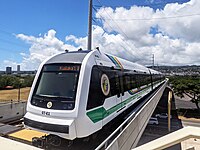
Photo from wikipedia
Abstract Since the 1980s, significant investments have been made in urban rail transit across the United States, particularly using light rail technology. Most of these light rail systems have been… Click to show full abstract
Abstract Since the 1980s, significant investments have been made in urban rail transit across the United States, particularly using light rail technology. Most of these light rail systems have been built in Sunbelt cities which no longer had legacy rail systems. As a result, they were constructed using a building blocks approach, being funded corridor by corridor. Most research, however, on urban rail performance has taken place at the system-wide level, leaving a significant gap at the level of the transit corridor. This research examined nineteen urban rail corridors in Denver, Salt Lake City, and Portland. A performance score was constructed for each corridor based upon ridership per mile, ridership growth, capital costs, and the cost of ongoing operations. These scores were then compared with the geographic profile of each corridor studied. Corridors in each city ranked high and low, with no city emerging as a clear frontrunner. More centrally-located corridors in each city registered the highest performance scores, while longer corridors in more peripheral locations had lower performance scores. Headways, population density, job density, walkability, and percentage renter occupied housing units were found to have a statistically significant relationship with high corridor performance, largely in line with previous studies, though median income, bus connections, and park and ride spaces were not found to increase performance in this study.
Journal Title: Journal of Transport Geography
Year Published: 2020
Link to full text (if available)
Share on Social Media: Sign Up to like & get
recommendations!